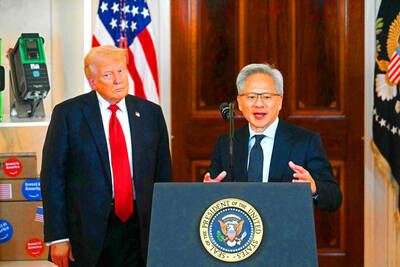China’s chip industry is growing faster than anywhere else in the world, after US sanctions on local champions — from Huawei Technologies Co (華為) to Hikvision Digital Technology Co (海康威視) — spurred appetite for homegrown components.
Nineteen of the world’s 20 fastest-growing chip industry firms over the past four quarters, on average, hail from the world’s No. 2 economy, data compiled by Bloomberg showed.
That compared with just eight firms at the same point last year.

Photo: Reuters
Revenue at China-based suppliers of design software, processors and gear vital to chipmaking is increasing at several times the pace of global leaders Taiwan Semiconductor Manufacturing Co (TSMC, 台積電) and ASML Holding NV.
That supercharged growth underscores how tensions between Washington and Beijing are transforming the global US$550 billion semiconductor industry.
In 2020, the US began restricting sales of local technology to companies such as Semiconductor Manufacturing International Corp (SMIC, 中芯國際) and Hikvision, successfully containing their growth — but also fueling a boom in Chinese chipmaking and supply.
Beijing is expected to orchestrate billions of dollars of investment in the sector under ambitious programs such as its “Little Giants” blueprint to endorse and bankroll national tech champions, and encourage “buy China” tactics to sidestep US sanctions.
The rise of indigenous names has caught the attention of some of the pickiest clients: Apple Inc was said to consider Yangtze Memory Technologies Co (長江存儲) as its latest supplier of iPhone flash memory.
“The biggest underlying trend is China’s quest for self-sufficiency in the supply chain, catalyzed by COVID-related lockdowns,” Morningstar analyst Phelix Lee (李旭暘) wrote in an e-mail. “Amid lockdowns, Chinese customers who mostly use imported semiconductors need to source homegrown alternatives to ensure smooth operations.”
At the heart of Beijing’s ambitions is the impetus to wean itself off a geopolitical rival and more than US$430 billion of imported chipsets last year.
Orders for chip-manufacturing equipment from overseas suppliers rose 58 percent last year, as local plants expanded capacity, data provided by industry body SEMI showed.
That in turn is driving local business. Total sales from Chinese-based chipmakers and designers jumped 18 percent last year to a record of more than 1 trillion yuan (US$149.27 billion), the China Semiconductor Industry Association said.
A persistent chip shortage that is curtailing output at the world’s largest makers of vehicles and consumer electronics is also working in local chipmakers’ favor, helping Chinese suppliers more easily access the international market — sometimes with premiums tacked onto the best-selling products, such as auto and PC chips.
SMIC and Hua Hong Semiconductor Ltd (華虹半導體), the biggest contract chipmakers, have kept their Shanghai-based plants operating at almost full capacity even as the worst COVID-19 outbreak since 2020 paralyzes factories and logistics across China.
With local authorities’ help, cargo flights from Japan delivered essential materials and gear to chip plants as the city went under lockdown.
SMIC recently reported a 67 percent surge in quarterly sales, outpacing far larger rivals GlobalFoundries Inc and TSMC.
High demand for surveillance products has pushed up revenue at Shanghai Fullhan Microelectronics Co (富瀚微電子) 37 percent on average. The video chip designer has pledged to expand into electric vehicles and artificial intelligence after winning its “Little Giant” designation.
Design tool developer Primarius Technologies Co (概倫電子) has doubled sales on average over the past four quarters, saying that it has developed software that can be used in making 3-nanometer chips.
Putting aside long-term profitability concerns, Lee said that the aggressive capacity buildup from Chinese players is expected to elevate their presence globally — which is raising hackles in Washington.
“America is on the verge of losing the chip competition,” international relations scholar Graham Allison and former Google CEO Eric Schmidt said in a Wall Street Journal column.
“If Beijing develops durable advantages across the semiconductor supply chain, it will generate breakthroughs in foundational technologies that the US cannot match,” they wrote.

Taiwan Semiconductor Manufacturing Co (TSMC, 台積電) last week recorded an increase in the number of shareholders to the highest in almost eight months, despite its share price falling 3.38 percent from the previous week, Taiwan Stock Exchange data released on Saturday showed. As of Friday, TSMC had 1.88 million shareholders, the most since the week of April 25 and an increase of 31,870 from the previous week, the data showed. The number of shareholders jumped despite a drop of NT$50 (US$1.59), or 3.38 percent, in TSMC’s share price from a week earlier to NT$1,430, as investors took profits from their earlier gains

AI TALENT: No financial details were released about the deal, in which top Groq executives, including its CEO, would join Nvidia to help advance the technology Nvidia Corp has agreed to a licensing deal with artificial intelligence (AI) start-up Groq, furthering its investments in companies connected to the AI boom and gaining the right to add a new type of technology to its products. The world’s largest publicly traded company has paid for the right to use Groq’s technology and is to integrate its chip design into future products. Some of the start-up’s executives are leaving to join Nvidia to help with that effort, the companies said. Groq would continue as an independent company with a new chief executive, it said on Wednesday in a post on its Web

CHINA RIVAL: The chips are positioned to compete with Nvidia’s Hopper and Blackwell products and would enable clusters connecting more than 100,000 chips Moore Threads Technology Co (摩爾線程) introduced a new generation of chips aimed at reducing artificial intelligence (AI) developers’ dependence on Nvidia Corp’s hardware, just weeks after pulling off one of the most successful Chinese initial public offerings (IPOs) in years. “These products will significantly enhance world-class computing speed and capabilities that all developers aspire to,” Moore Threads CEO Zhang Jianzhong (張建中), a former Nvidia executive, said on Saturday at a company event in Beijing. “We hope they can meet the needs of more developers in China so that you no longer need to wait for advanced foreign products.” Chinese chipmakers are in

POLICY REVERSAL: The decision to allow sales of Nvidia’s H200 chips to China came after years of tightening controls and has drawn objections among some Republicans US House Republicans are calling for arms-sale-style congressional oversight of artificial intelligence (AI) chip exports as US President Donald Trump’s administration moves to approve licenses for Nvidia Corp to ship its H200 processor to China. US Representative Brian Mast, the Republican chairman of the US House Committee on Foreign Affairs, which oversees export controls, on Friday introduced a bill dubbed the AI Overwatch Act that would require the US Congress to be notified of AI chips sales to adversaries. Any processors equal to or higher in capabilities than Nvidia’s H20 would be subject to oversight, the draft bill says. Lawmakers would have